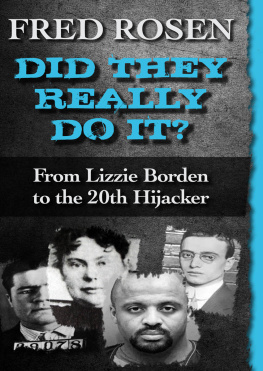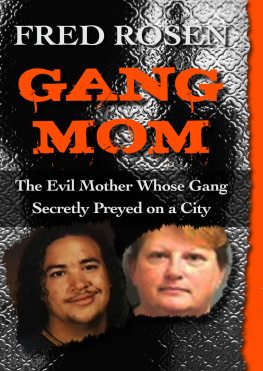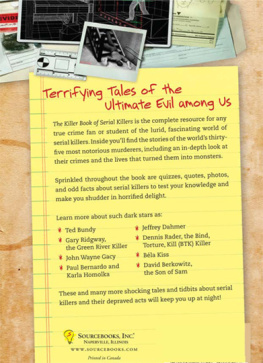trails of death
THE TRUE STORY OF NATIONAL FOREST SERIAL KILLER GARY HILTON
trails of death
THE TRUE STORY OF NATIONAL FOREST SERIAL KILLER GARY HILTON
Fred Rosen

trails of death
Copyright 2011 Fred Rosen
All rights reserved. No portion of this book may be reproduced in whole or in part, by any means whatsoever, except for passages excerpted for the purposes of review, without the prior written permission of the publisher. For information, or to order additional copies, please contact:
TitleTown Publishing, LLC
P.O. Box 12093 Green Bay, WI 54307-12093
920.737.8051 | titletownpublishing.com
Editor: Paul Dinas
Associate Editor: Stephanie Finnegan
Production Editor: Martin Lederman
Cover Designers: Jill Boltin and Erika L. Block
Interior Designer: Erika L. Block
PUBLISHERS CATALOGING-IN-PUBLICATION DATA:
Rosen, Fred.
Trails of Death : Gary Hilton, The national Forest Killer / Fred Rosen. -- 1st ed. -- Green Bay, WI : TitleTown Pub., c2011.
p. ; cm.
ISBN: 978-0-9837547-2-5
1. Hilton, Gary. 2. Serial murders--United States. 3. Serial murder investigation--United States. 4. Serial murderers--United States. 5. Murder--Investigation--United States. 6. National parks and reserves--United States--History. I. Title.
HV8079.H6 R67 2011
364.152320973--dc22 1109
Printed in the USA by Thomson-Shore first edition  printed on recycled paper
printed on recycled paper
10 9 8 7 6 5 4 3 2 1
For Sammy, my trusted and constant companion, who was with me every step of the way.
My last wish is to send my love to my mother.
Francis Two-Gun Crowley, upon his execution
at Sing Sing, January 21, 1932
A Word About Sources
The names of some individuals have been changed to preserve their anonymity. The goal in all cases is to protect their privacy without damaging the integrity of the story.
This book is based upon a three-and-a-half-year investigation that includes primary interviews, official statements given by participants during interviews with law enforcement, prosecutors or public defenders, and trial testimony. Two people I wanted to talk to, I did not.
Meredith Emersons parents have never commented about their daughter. That is more than understandable. It could have been anyones child. That is the reason I undertook this three-and-a-half-year journey over six decades into the past and then back again, physically through four statesto find out why.
Dino Sclafani, Roy Cave and Sandy Carr filled in a lot of gaps in Garys life. My researcher, Jaime Granger, inundated me with so many e-mails, my computer crashed! She took me under her protective wing in Leon and Wakulla Counties and really showed me around.
Where dialogue has been reconstructed, it is on the basis of the memories of those interviewed and the official documents. As with any homicide case, there are sometimes different memories of the same event. In those cases I have evaluated the competing claims and presented an account based on my considered journalistic judgment of what happened.
prologue
Bob Bryant was worried. Really worried. For weeks he hadnt been able to get in touch with his parents by phone or e-mail. Their neighbors told him that newspapers were piling up outside their house.
Irene and John Bryant were avid hikers, a devoted couple married for fifty-five years. On October 20, 2007, they had gone hiking in western North Carolinas Pisgah National Forest in the Pink Beds Loop Trail area. Since then, neither family nor friends had seen or heard from them. Bob Bryant, who lived in Texas, flew to North Carolina in early November and immediately went to his parents house. Gaining entrance, he found nothing unusual except that their backpacks were gone.
Where were his parents? He called police to report his eighty-four-year-old mother and seventy-nine-year-old father missing. As part of the first group of searchers in the forest, Bob happened upon his parents abandoned red Ford Escape parked on the east side of Yellow Gap Road, off U.S. Highway 276. There were no signs of a struggle. Then the pros took over. Searchers with dogs began combing the hiking trials rather than using the abandoned car as the starting point for their labors. Had they done the latter, Irene Bryant would have been found almost immediately.
While the searchers hit the trails for a full three days, in which they found nothing, police discovered that at four oclock in the afternoon on the day Irene disappeared, someone had placed a 911 call from her cell phone, which was dropped because of a weak signal. A few days later, their ATM card was used seventy-five miles away at a bank in nearby Ducktown, Tennessee, to withdraw $300. Ducktown is where the states of Tennessee, North Carolina and Georgia all touch.
Finally, after three days, on November 9, searchers discovered the decomposing body of a female only twenty-five yards from the abandoned Ford Escape. She was wearing pants, underwear, T-shirt, a bra, white sock and blue sock and one hiking boot on the left foot. Police found her long-sleeved shirt and the right hiking boot near her body. They soon identified the victim as Irene Bryant.
According to her autopsy report, Irene Bryant was hit multiple times in the head, fracturing her skull each time. The blows that had killed her had been made by some blunt object, like a hammer or a jack handle. The left forearm was broken, with all the fingers of the same hand fractured. That implied that she had held her arm up to ward off the killers blows.
Her right forearm was another story. Either someone had severed it below the elbow for some unknown reason, or the carrion-feeders had gotten to it. A further analysis of the severed bones by a forensic anthropologist could determine how the arm had become detached from the body.
Bob Bryantand his sister, Holly, who lived in Floridawere left to mourn for their mother, to arrange for her funeral, even while their father, John, continued to remain missing. Police searched for him throughout the South. They hoped that when they found John Bryant, they would also find who had abducted and killed his wife, Irene.
The hunt had begun on both sides of the law.
part one
perpetual maneuvers
chapter
1
Crawfordville Highway is a four-lane blacktop in the Florida Panhandle. Starting in Leon County, it stretches south from Tallahassee, the county seat and state capital, over miles of sparsely populated land dotted with filling stations and chain stores. Once outside Tallahassee, it winds at points through the Apalachicola National Forest.
The 532,000-square-acre forest is a brilliant green-canopied preserve of pine, scrub and huge water oaks, lots of sand and palmetto bushes. The pine trees grew so thick and high in the summer that the Florida sunshine could hardly penetrate it. The ground beneath the trees was covered with thick green palmetto bushes with sharp bayonet fronds.
Two-rut roads crisscrossed the forests. Frequently used by loggers, they intersected with dusty, one-rut roads dotted with oyster shells. June Drake could hear them crunching occasionally under the wheels of her Jeep. As a national park rangera federal law enforcement officer with the same powers in the Apalachicola that a cop has on the streetshe was on a routine patrol through her area on November 17 when she came upon a white Chevy Astro van. Parked at a campsite halfway back next to Moore Lake, it had Georgia tags that were soon to expire. The inside windows had tightly pulled black curtains.
Next page

















 printed on recycled paper
printed on recycled paper